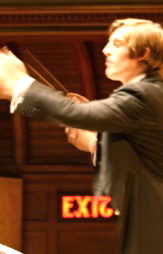PROGRAM NOTES: In residence at the Brevard Music Center, in the solitude of the Blue Ridge Mountains, I started writing 27 Morningside with purely musical ideas in mind: the gradual evolution of a rhythm of African derivation; the sustained integration of extended techniques; the shifting of context around a common motivic thread. But as the narrative arc of the piece developed, I realized I’d been expressing more emotion than I’d first intended. Written in the summer of 2010, while my family was separating and the last wisps of childhood were fluttering through my fingers, 27 Morningside became for me a sort of ode to home, a testament to wonderful moments passed. To some extent, you can hear the sounds of our house in the piece: an unrelenting bustle, some unexpected interruptions, and various people knocking on the door. But 27 Morningside is only loosely programmatic. It’s meant to convey, above all else, the spirit of home and that feeling, both wistful and heartening, that comes with the remembrance of the many things home has offered over the years. Compo Moonrise and Sasco Creek continue the meditation on those themes, each depicting a hometown setting that’s captivated me: Compo Moonrise recalls the haunted feeling of an evening on the beach, and Sasco Creek tries to capture the energy of a run towards the sea. But they, like 27 Morningside, are only loosely programmatic; it’s my ultimate hope that their soundscapes will engender in you the same kind of inspiration the places have offered me.
PROGRAM NOTES: “The ninth wave” was originally a sailor’s term used to describe a single wave larger than all the others. They’re the stuff of legend—colossal, unpredictable, and indomitable, waves so big they look like massive walls of water behind deep holes in the sea. Few who have seen them have ever survived, and while a recent satellite study confirmed their existence, their cause remains utterly mysterious.
Russian painter Ivan Aivazovsky was impressed enough by sailors’ tales that he titled his 1850 masterpiece “The Ninth Wave.” It depicts a tiny group of people clinging to the mast of their wrecked ship, still stranded in the middle of a merciless sea. Completely indifferent to their struggle, a beautiful sunrise dominates the work, shining through the chaos and casting the brutal waves in a strangely positive light. The subject matter here is tragic—the sailors may very well face death—and yet the sunrise spells hope, the promise of another day to come. As viewers, we’re forced to confront this duality, somehow trying to reconcile the sailors’ plight with the overwhelming beauty of the seascape around them.
Aivazovsky’s work has been called “an ode to human daring in the face of the elements,” and that’s how I like to think of my piece, too. I used the painting as a loose source of narrative inspiration for this music—see if you can hear the storm gather at sea, the sailors nearly beating the elements, and the panic of their eventual shipwreck. As they’re left adrift, battered and totally alone, the piece sways with slow, ambiguous harmonies, leaving us to wonder what ultimately becomes of these men. Do they emerge alive, or does the sunrise offer nothing more than bitterly false hope? As you listen, I hope you’ll try to answer that question for yourself, thinking all the while about the awesome power of nature in all its violence and beauty.





